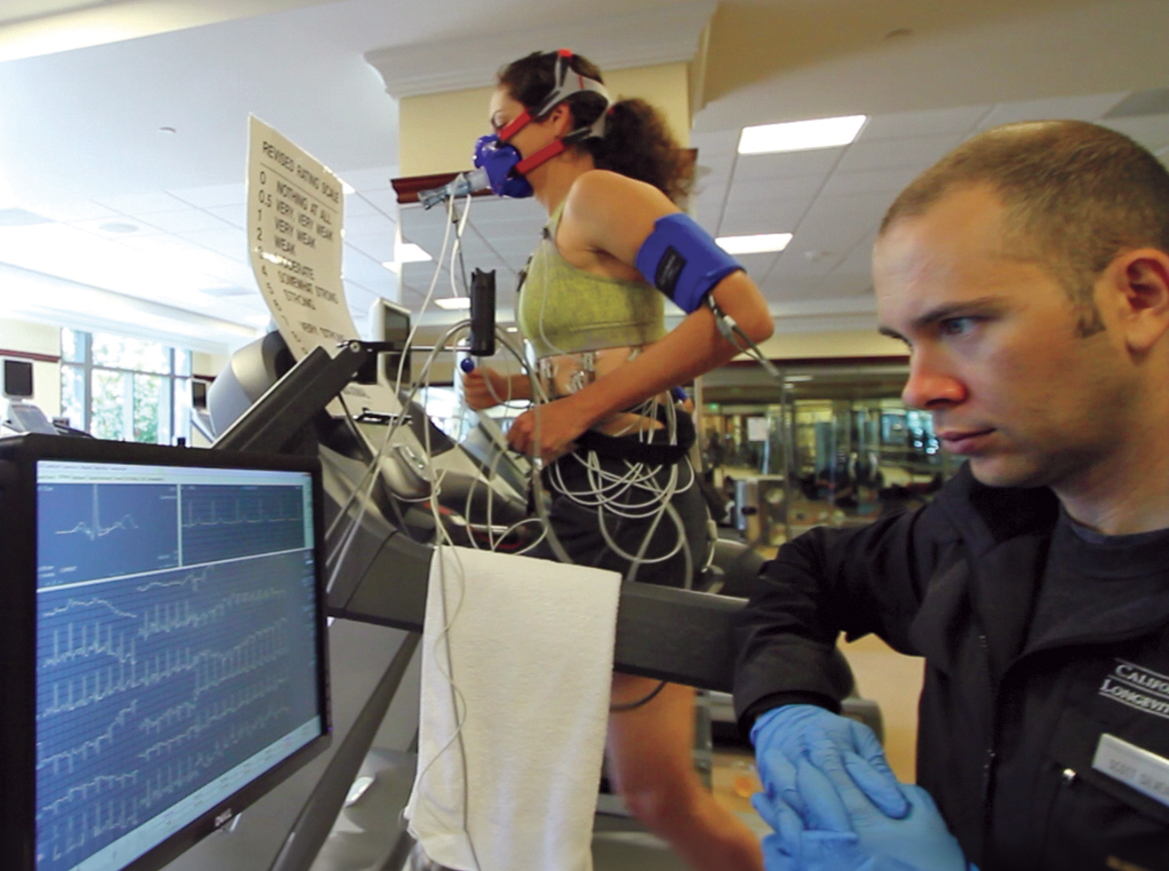
Cenegenics and Westlake Center for Health & Wellbeing Espouse the Progressive Art of Aging
High-tech aging.
-
CategoryHealth
-
Written byLinda Grasso

Both Cenegenics and Westlake Village Center offer the VO2 max test, which measures your body’s ability to consume and utilize oxygen.
For all its successes, mainstream medicine has failed to make much progress against the diseases of aging that kill most people: heart disease, cancer, Alzheimer’s and type 2 diabetes. When those diseases strike, we seek treatments—but often it is too late. We may continue living, but our quality of life decreases.
Enter medicine 3.0—a new school of thought being embraced by a growing number of physicians as well as health and longevity centers around the country. This approach goes beyond even functional medicine which, instead of merely treating symptoms, is aimed at addressing the root cause of a health issue or illness. Medicine 3.0 takes it a step further. It advocates for people to undergo a battery of diagnostic—and in some cases, high-tech—tests to learn about their body. The information yielded is then used to formulate plans of action for maintaining peak cognitive, physical and metabolic health.
Medicine 3.0 has become a water cooler topic of late partly due to the 2023 New York Times bestseller Outlive: The Science and Art of Longevity—a manifesto on living better and longer by physician Peter Attia and coauthor Bill Gifford. In it, Attia draws on the latest science to deliver innovative nutritional interventions, techniques for optimizing exercise and sleep, and tools for addressing emotional and mental health.
Biomarkers—measurements of blood, tissue or other bodily fluids that can indicate a disease or condition—are an important tool in medicine 3.0. And they are a critical measurement used in the health and longevity centers that have popped up all over the country. At the Westlake Village Center for Health & Wellbeing (part of the Four Seasons Hotel Westlake Village), biomarkers are credited for taking a lot of the guesswork out of health evaluations.
“People have a lot more knowledge and information than they ever did before,” says the center’s executive director, Victoria Nickle. “People used to think, ‘Hey, I smoke. I might get lung cancer, but I might not because my grandma smoked until she was 101, and she’s great.’ But with so much testing available, people are starting to take hold of their health a bit more and realize that you can actually get data based on where you are at right now. And when you make any change, no matter how small, you can actually start staving off the progression of inevitable decline.”
Cenegenics is another longevity-focused health center in SoCal. Founded in 1997, it now runs 22 centers across the U.S., including one in Beverly Hills. Rudy Inaba, Cenegenics’ vice president of performance health, says the company’s growth is reflective of our growing shift in mindset about aging.
“It used to be like I want to live to be a certain age, and I accept the fact that I’m not going to be able to lift weights or pick up my grandchild,” says Rudy. “Look, we are all going to get older, and things will get harder. But you don’t have to accept that there is nothing you can do. There are concrete things you can do to maintain, preserve and maximize.”
Patients at longevity facilities run the full gamut—from high-performing, highly stressed, fatigued executives to people who have recently experienced a health scare or loss of a loved one. Patients typically undergo a daylong series of tests. Then, results in hand, they meet with a roster of professionals—physicians, nutritionists, fitness coaches, sleep experts and therapists—who create a plan of action.
Both Cenegenics and Westlake Village Center point to the VO2 max test as a critical tool in evaluating health. VO2 max is a measurement of your body’s ability to consume and utilize oxygen. In other words, a measurement of fitness. The 15-minute test, performed while you’re on a bike and connected to a machine that analyzes expired air, provides data on pulmonary health. “We want to see how well your heart, lungs and muscles work during exercise,” Rudy explains.
“There are concrete things you can do to maintain, preserve and maximize.”
A VO2 max reading can determine if a patient is having pulmonary, cardiovascular, blood vessel or muscular limitations. How well a patient recovers from the test is also insightful. Assessing recovery can be a strong measure of cardiovascular risk.
While many people opt for what they believe are quick fixes such as cleanses, fad diets and miracle supplements to feel better, longevity experts concur that fitness is a smarter choice.
“Just improving fitness helps establish better nutrition, sleep, stress management, strength, and cardiovascular health,” Rudy shares. “Typically if someone really doubles down on fitness—essentially saying ‘I’m going to do everything in my power to improve my fitness level’—that’s going to optimize your health span and longevity.”
Another popular test offered at both facilities: the DEXA scan, a noninvasive body composition test that measures bone density, body fat and lean muscle mass. That information can help assess, for example, your risk of osteoporosis and hip fractures.
Why is all this information worth knowing? It could save your life. Take hip fracture risk, for example. More than 300,000 Americans over the age of 65 suffer a hip fracture each year. According to the National Institutes of Health, mortality within one year of the fracture ranges from 18% to 33%. The increased risk persists even beyond 10 years of the break. Bottom line: A good plan of action includes steps that you can take now to avoid this type of injury in your twilight years.
This is why risk mitigation is critical part of medicine 3.0. If, for example, the DEXA scan shows too much body fat and not enough muscle mass, an appropriate diet and exercise plan can be implemented and other health risk factors can be identified.
Rudy explains: “In that kind of situation—too much fat and not enough muscle mass—we can identify risk factors related to sarcopenia, the age-related loss of muscle mass over time. Sarcopenia can impact lifestyle: not being able to put away groceries on the top shelf or walk from a far parking space. Those activities are all tied into how much muscle mass and how much muscular strength you have.” An exercise plan might be developed to build muscle mass through strength training, and a dietary plan to increase protein intake.
So what does a day at one of these facilities look like? Victoria says typically a patient at the Westlake Village Center will undergo a full physical exam, and each service provided will lead to the next one. For example, a patient might go for a chest X-ray and a DEXA scan in the morning and then in the afternoon undergo performance testing. By afternoon, the test results of the X-ray and the scan are available. So by the time the patient does a VO2 max test, the clinical exercise physiologists have the information from the morning’s tests at hand. Late in the day a patient might do brain mapping, in which electrodes are used to see how your brain responds to stress. Patients who suffer from stress and anxiety can meet with a licensed therapist who can share cognitive behavioral techniques to help them cope.
What about cost? First: Count on most of it being out of pocket. While insurance may cover a test here or there, most patients pay themselves. Secondly: It is not cheap. An entry-level program at Cenegenics is $1,500 a year (including DEXA scans and VO2 max tests each quarter), rising to $4,495 for a full performance health assessment. That includes a comprehensive set of labs that are drawn at your home, analzing everything from organ function to cardiovascular and hormone health. The ultimate performance health assessment at Cenegenics includes, among other things, a full-body MRI as well as a CCTA (coronary computed tomography angiography), which shows one’s risk of having a cardiovascular event. The ultimate assessment costs around $15,000.
Point of fact: You can get some of these tests without going to a longevity center, but it is worth noting that knowledge is one thing; what you do with it is another. I got a keen understanding of that this past year. My husband and I, both middle-agers who work hard to stay fit, decided to have a CT scan done on our hearts. We wanted to make sure everything was functioning properly. Our traditional internist sent us to a traditional cardiologist who delivered our test results: “Everything is OK for both of you. No problems spotted.” A medicine 3.0 conversation might have gone like this: Your tests showed you are in the healthy range. Now, what can we do to optimize the health of your heart, helping it function even better at your age and beyond? Now, that would have been interesting.
The Building Boom in the Valley for Senior Living Communities Has Escalated
Upscale livin’ for active retirees.











